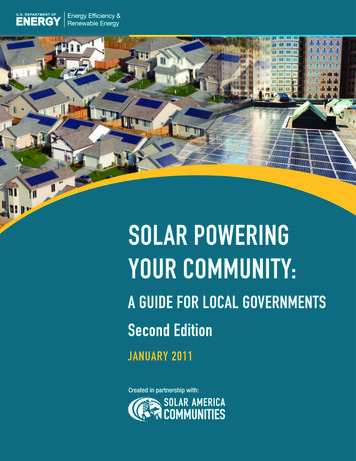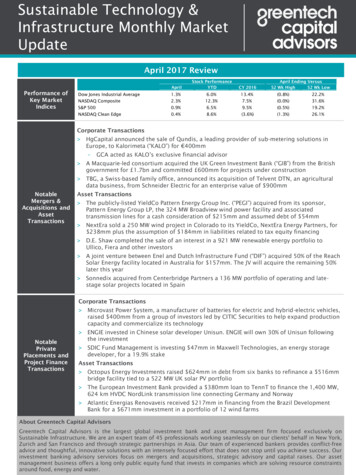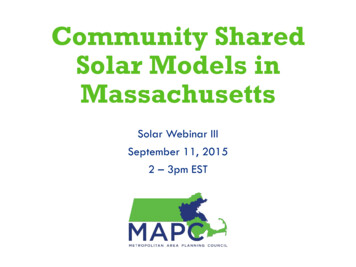
Transcription
NOTICEThis report was prepared as an account of work sponsored by an agency ofthe United States government. Neither the United States government nor anyagency thereof, nor any of their employees, makes any warranty, expressor implied, or assumes any legal liability or responsibility for the accuracy,completeness, or usefulness of any information, apparatus, product, orprocess disclosed, or represents that its use would not infringe privatelyowned rights. Reference herein to any specific commercial product, process,or service by trade name, trademark, manufacturer, or otherwise doesnot necessarily constitute or imply its endorsement, recommendation, orfavoring by the United States government or any agency thereof. The viewsand opinions of authors expressed herein do not necessarily state or reflectthose of the United States government or any agency thereof.Free download available atwww.solaramericacommunities.energy.govAvailable electronically atwww.osti.gov/bridgeAvailable for a processing fee to U.S. Department of Energyand its contractors, in paper, from:U.S. Department of EnergyOffice of Scientific and Technical InformationP.O. Box 62Oak Ridge, TN 37831-0062phone: 865.576.8401fax: 865.576.5728e-mail: reports@adonis.osti.govAvailable for sale to the public, in paper, from:U.S. Department of CommerceNational Technical Information Service5285 Port Royal RoadSpringfield, VA 22161phone: 800.553.6847fax: 703.605.6900e-mail: orders@ntis.fedworld.govonline ordering: www.ntis.gov/ordering.htmPrinted on paper containing at least 50% wastepaper,including 10% post consumer waste.bSolar Powering Your Community: A Guide for Local Governments January 2011
AcknowledgmentsDOE funded the development of this guide through the Solar Market Transformationsubprogram. The guide represents a collaborative effort among multiple solar markettransformation partners. DOE would like to thank the following organizations for theirinvaluable contributions to writing and reviewing this guide. California Center for Sustainable Energy (http://energycenter.org) CH2M HILL (www.ch2m.com/corporate) Critigen (www.critigen.com) Florida Solar Energy Center (www.fsec.ucf.edu/en) Interstate Renewable Energy Council (www.irecusa.org) Lawrence Berkeley National Laboratory (www.lbl.gov) National Renewable Energy Laboratory (www.nrel.gov) Network for New Energy Choices (www.newenergychoices.org) North Carolina Solar Center (www.ncsc.ncsu.edu) Oak Ridge National Laboratory (www.ornl.gov) Sandia National Laboratories (www.sandia.gov) Solar Electric Power Association (www.solarelectricpower.org) Southwest Technology Development Institute (www.nmsu.edu/ tdi) Vote Solar Initiative (www.votesolar.org)Much of the information included in this report is from the Database of State Incentives forRenewables & Efficiency (DSIRE, www.dsireusa.org), a public resource funded by DOE. Thedatabase is a product of the ongoing efforts of the North Carolina Solar Center in partnershipwith the Interstate Renewable Energy Council (IREC).DOE thanks all organizations that contributed staff time and resources for writing and reviewingthe implementation examples, which describe work undertaken in communities across the nation,including DOE’s 25 partner Solar America Cities (see www.solaramericacities.energy.gov for alist). The department also thanks local government staff and partnering organizations for theirongoing efforts to integrate solar energy into their respective communities.The additional references and resources in this guide are the result of the efforts of numerousorganizations that are leading solar market transformation across the country; DOE thanks theseorganizations for accelerating the adoption of solar energy in the United States.Solar Powering Your Community: A Guide for Local Governments January 2011i
iiSolar Powering Your Community: A Guide for Local Governments January 2011
EXECUTIVE SUMMARYAs demand for energy increases, many communities are seeking ways to meet this demand withclean, safe, reliable energy from renewable sources such as sun and wind. Fortunately, manyof the key technologies that can unlock the power of these renewable resources are availableon the market today. While the U.S. Department of Energy (DOE) continues to fund researchand development (R&D) to improve solar technologies, DOE is also focusing on accelerating arobust nationwide market for the currently available technologies.Development of a nationwide market requires overcoming barriers to widespread adoptionof solar energy technologies. These barriers include complicated procedures for permittingand connecting systems to the grid, financing challenges, a lack of awareness of solar energysolutions among key decision makers, and a lack of trained installation contractors. Localgovernments are uniquely positioned to remove many of these barriers, clearing the way forsolar markets to thrive in their locales. Representatives of local governments who understand andprepare for policy and market changes can optimally position their communities in the emergingrenewable energy economy.To accelerate the nationwide adoption of solar energy, DOE established partnerships with 25 “SolarAmerica Cities” around the United States. Local organizations and policy makers in each SolarAmerica City are taking a comprehensive approach to bringing solar to their cities. Their work laysthe foundation for a viable solar market and offers a model for other communities to follow.As a result of the progress made in the 25 Solar America Cities, in 2010 DOE announced anew effort to share the best practices developed with thousands of local governments acrossthe nation. As part of this evolution, DOE created a broader program called Solar AmericaCommunities to reflect the intention to promote solar market development within cities, counties,and all other local jurisdictions.Solar Powering Your Community: A Guide for Local Governments is a comprehensive resourceDOE created to assist local governments and stakeholders in designing and implementing astrategic local solar plan. This guide includes examples and models that have been field-tested incities and counties around the country. Many of the examples are the direct result of DOE’s SolarAmerica Communities program.This guide can help stimulate ideas or provide a framework for a comprehensive solar plan fora community. Each section is divided into topic areas—typically within the jurisdiction of localgovernments—that are integral in creating and supporting local solar markets. Each topic areaincludes: An introduction that describes the policy or program and states its purpose Information on benefits of implementing the policy or program Tips and options for designing and implementing the policy or program Examples that highlight experiences from communities that have successfully implemented the policy or program; and additional reports, references, and tools that can offer moreinformation on the topic.Solar Powering Your Community: A Guide for Local Governments January 2011iii
DOE recognizes that there is no one path to solar market development, so this guide introducesa range of policy and program options that can help a community build a sustainable solarinfrastructure. DOE doesn’t imply that a community must undertake all of these activities;instead, community leaders should tailor their approach to fit their community’s particular needsand market barriers.This second edition of the guide was updated to include new market developments andinnovations for advancing local solar markets that have emerged since the first edition wasreleased in 2009. DOE plans to continually revise and improve the content as new strategies arisefor moving solar energy into the mainstream. Comments and suggestions are welcomed and canbe submitted at solarguide@ee.doe.gov. The entire guide can be downloaded fromwww.solaramericacommunities.energy.gov.ivSolar Powering Your Community: A Guide for Local Governments January 2011
TABLE OF CONTENTSIntroduction . . . . . . . . . . . . . . . . . . . . . . . . . . . . . . . . . . . . . . . . . . . . . . . . . . . . . . . . . . . . . . . . . . . . . 1Getting Started: Assessing A Community’s Policy Environment . . . . . . . . . . . . . . . . . . . . . . 31.0 Organizing and Strategizing A Local Solar Effort . . . . . . . . . . . . . . . . . . . . . . . . . . . . . . . 51.1 Create a Solar Advisory Committee or Task Force. . . . . . . . . . . . . . . . . . . . . . . . . . . . . . . . . .1.2 Hire or Designate a Local Solar Coordinator. . . . . . . . . . . . . . . . . . . . . . . . . . . . . . . . . . . . . .681.3 Survey Residents and Businesses To Identify Barriers. . . . . . . . . . . . . . . . . . . . . . . . . . . . . . . 101.4 Conduct an Installation Baseline Survey. . . . . . . . . . . . . . . . . . . . . . . . . . . . . . . . . . . . . . . . . . 131.5 Establish Solar Installation Targets. . . . . . . . . . . . . . . . . . . . . . . . . . . . . . . . . . . . . . . . . . . . . . 161.6 Include Solar in Broader City, County, or Regional Planning Efforts . . . . . . . . . . . . . . . . . . . 202.0 Making Solar Affordable for Residents and Businesses . . . . . . . . . . . . . . . . . . . . . . . . . . 232.1 Renewable Portfolio Standards. . . . . . . . . . . . . . . . . . . . . . . . . . . . . . . . . . . . . . . . . . . . . . . . . 252.2 Cash Incentives. . . . . . . . . . . . . . . . . . . . . . . . . . . . . . . . . . . . . . . . . . . . . . . . . . . . . . . . . . . . . 282.3 Feed-In Tariffs. . . . . . . . . . . . . . . . . . . . . . . . . . . . . . . . . . . . . . . . . . . . . . . . . . . . . . . . . . . . . . 332.4 Third-Party Residential Financing Models. . . . . . . . . . . . . . . . . . . . . . . . . . . . . . . . . . . . . . . . 372.5 Property Assessed Clean Energy Financing . . . . . . . . . . . . . . . . . . . . . . . . . . . . . . . . . . . . . . . 412.6 Low-Interest Loans. . . . . . . . . . . . . . . . . . . . . . . . . . . . . . . . . . . . . . . . . . . . . . . . . . . . . . . . . . 462.7 Group Purchasing . . . . . . . . . . . . . . . . . . . . . . . . . . . . . . . . . . . . . . . . . . . . . . . . . . . . . . . . . . . 492.8 Community Solar. . . . . . . . . . . . . . . . . . . . . . . . . . . . . . . . . . . . . . . . . . . . . . . . . . . . . . . . . . . . 512.9 Property and Sales Tax Incentives. . . . . . . . . . . . . . . . . . . . . . . . . . . . . . . . . . . . . . . . . . . . . . . 553.0 Updating and Enforcing Local Rules and Regulations . . . . . . . . . . . . . . . . . . . . . . . . . . . 593.1 Solar Access and Solar Rights Laws. . . . . . . . . . . . . . . . . . . . . . . . . . . . . . . . . . . . . . . . . . . . . 603.2 Solar-Ready Building Guidelines. . . . . . . . . . . . . . . . . . . . . . . . . . . . . . . . . . . . . . . . . . . . . . . 643.3 Streamlined Solar Permitting and Inspection Processes. . . . . . . . . . . . . . . . . . . . . . . . . . . . . . 673.4 Code Official Training. . . . . . . . . . . . . . . . . . . . . . . . . . . . . . . . . . . . . . . . . . . . . . . . . . . . . . . . 723.5 Installer Licensing and Certification. . . . . . . . . . . . . . . . . . . . . . . . . . . . . . . . . . . . . . . . . . . . . 754.0 Improving Utility Policies and Processes . . . . . . . . . . . . . . . . . . . . . . . . . . . . . . . . . . . . . . . 814.1 Interconnection Standards. . . . . . . . . . . . . . . . . . . . . . . . . . . . . . . . . . . . . . . . . . . . . . . . . . . . . 824.2 Net-Metering Rules. . . . . . . . . . . . . . . . . . . . . . . . . . . . . . . . . . . . . . . . . . . . . . . . . . . . . . . . . . 874.3 Rate Structures that Appropriately Value Solar . . . . . . . . . . . . . . . . . . . . . . . . . . . . . . . . . . . . 935.0 Creating Jobs and Supporting Economic Development . . . . . . . . . . . . . . . . . . . . . . . . . . 975.1 Recruit the Solar Industry. . . . . . . . . . . . . . . . . . . . . . . . . . . . . . . . . . . . . . . . . . . . . . . . . . . . . 985.2 Develop Local Workforce Training and Education Programs. . . . . . . . . . . . . . . . . . . . . . . . . . 103Solar Powering Your Community: A Guide for Local Governments January 2011v
6.0 Educating and Empowering Potential Customers . . . . . . . . . . . . . . . . . . . . . . . . . . . . . . . 1096.1 Consumer Outreach and Education Programs. . . . . . . . . . . . . . . . . . . . . . . . . . . . . . . . . . . . . . 1106.2 Demonstration Projects with an Educational Component. . . . . . . . . . . . . . . . . . . . . . . . . . . . . 1146.3 Customer Assistance Programs. . . . . . . . . . . . . . . . . . . . . . . . . . . . . . . . . . . . . . . . . . . . . . . . . 1176.4 Solar Mapping as an Outreach Tool . . . . . . . . . . . . . . . . . . . . . . . . . . . . . . . . . . . . . . . . . . . . . 1206.5 Solar in K-12 Curriculum. . . . . . . . . . . . . . . . . . . . . . . . . . . . . . . . . . . . . . . . . . . . . . . . . . . . . 1237.0 Leading By Example with Installations on Government Properties . . . . . . . . . . . . . . . 1277.1 Identify Optimal Installation Locations. . . . . . . . . . . . . . . . . . . . . . . . . . . . . . . . . . . . . . . . . . . 1297.2 Standardize Solicitations for Solar Installations. . . . . . . . . . . . . . . . . . . . . . . . . . . . . . . . . . . . 1337.3 Select the Appropriate Financing Mechanism. . . . . . . . . . . . . . . . . . . . . . . . . . . . . . . . . . . . . . 137Tax-Exempt Financing . . . . . . . . . . . . . . . . . . . . . . . . . . . . . . . . . . . . . . . . . . . . . . . . . . . . . . . 137Tax Credit Bond Financing. . . . . . . . . . . . . . . . . . . . . . . . . . . . . . . . . . . . . . . . . . . . . . . . . . . . 138Third-Party Finance Models. . . . . . . . . . . . . . . . . . . . . . . . . . . . . . . . . . . . . . . . . . . . . . . . . . . 138Using Local Funds in Combination with Third-Party Finance Models . . . . . . . . . . . . . . . . . . 139Performance Contracting. . . . . . . . . . . . . . . . . . . . . . . . . . . . . . . . . . . . . . . . . . . . . . . . . . . . . . 1407.4 Commission the Solar Energy System and Ensure Quality Operations. . . . . . . . . . . . . . . . . . 1447.5 Host Wholesale Power Generators on Local Government Land or Facilities. . . . . . . . . . . . . . 147Glossary and Related Solar Terminology . . . . . . . . . . . . . . . . . . . . . . . . . . . . . . . . . . . . . . . . . . . 149Appendices . . . . . . . . . . . . . . . . . . . . . . . . . . . . . . . . . . . . . . . . . . . . . . . . . . . . . . . . . . . . . . . . . . . . . . 158List of Examples. . . . . . . . . . . . . . . . . . . . . . . . . . . . . . . . . . . . . . . . . . . . . . . . . . . . . . . . . . . . . . . . 158Abbreviations and Acronyms. . . . . . . . . . . . . . . . . . . . . . . . . . . . . . . . . . . . . . . . . . . . . . . . . . . . . . 161viSolar Powering Your Community: A Guide for Local Governments January 2011
INTINTRODUCTIONDemand for energy is continuing to rise, and communities are increasingly looking to renewablesources such as sun and wind to meet that demand with clean, safe, reliable energy. Fortunately,many of the key technologies that can unlock the power of these renewable resources are on themarket today. Rapidly declining prices for solar technologies, in combination with federal, state,and local policy changes, are bringing increasing amounts of solar energy into the mainstream.Local government representatives who understand and prepare for policy and market changeswill be able to best position their communities in this new renewable energy economy.The American Recovery and Reinvestment Act of 2009 (the Recovery Act) was signed into lawon February 17, 2009, providing unprecedented levels of investment in renewable energy. TheU.S. Department of Energy (DOE) is playing a significant role in the effort to reduce costs andincrease the use of renewable energy technologies.The BushnellCompany in theGermantownneighborhoodof Philadelphiauses an 85 kWrooftop PVinstallation.(Mercury SolarSolutions/PIX 18064)To accelerate the nationwide adoption of solar energy, DOE developed the Solar AmericaCities program, centered on partnerships with 25 major U.S. cities. This program is designed tocomplement top-down federal policy approaches with federal–local partnerships that are helpingto build a robust U.S. solar market.Local governments are in a unique position to remove many of the barriers to widespread solarenergy adoption and make solar energy more affordable and accessible for their residents andbusinesses. These barriers include complicated procedures for permitting and connecting systemsto the grid, financing challenges, a lack of awareness of solar energy solutions among key decisionmakers, and a lack of trained installation contractors. The 25 Solar America Cities vary by size,geographic location, and maturity of solar market, which has enabled DOE to identify challengesand solutions at various stages of market development. Local planners and policy makers ineach Solar America City are taking a comprehensive approach to bringing solar to their cities.Many of the examples presented in this guide are direct results of the DOE Solar America Citiespartnerships. To learn more about what these cities have accomplished, .As a result of widespread success in the 25 Solar America Cities, in 2010 DOE announced anew outreach effort to share the best practices developed in concert with thousands of localgovernments across the nation. As part of this evolution, DOE created a broader program calledSolar Powering Your Community: A Guide for Local Governments January 20111
INTINTRODUCTIONSolar America Communities, reflecting the intention to promote solar market development withincities, counties, and all other local jurisdictions. Solar America Communities program activitiesinclude the partnerships with the 25 Solar America Cities, along with “special project” awardsto develop innovative new approaches for increasing solar energy use, technical analyses onemerging market issues, and outreach to communities across the nation.DOE designed this guide—Solar Powering Your Community: A Guide for Local Governments—toassist local government officials and stakeholders in designing and implementing strategic localsolar plans. The 2010 edition contains the most recent lessons and successes from the 25 SolarAmerica Cities and other communities promoting solar energy. Because DOE recognizes thatthere is no one path to solar market development, this guide introduces a range of policy andprogram options that can help a community build a local solar infrastructure. Communities do notneed to undertake all of these activities; instead, each community should tailor its approach to fitits particular needs and market barriers.Each section of the guide is divided into topic areas—typically within the jurisdiction of localgovernments—that have been integral to creating and supporting local solar markets. Each topicarea begins with an introduction that describes the policy or program and states its purpose,followed by more information in several categories, as noted below:BENEFITSIdentifies benefits from implementing the policy or program.IMPLEMENTATION TIPS AND OPTIONSLists various tips and options for designing and implementing the policy or program.EXAMPLESHighlights experiences from communities that have successfully implemented the policy orprogram.ADDITIONAL REFERENCES AND RESOURCESLists reports, references, and tools that offer more information on the topic.Solar technologies fall into these main categories: photovoltaics (PV), concentrating solarpower (CSP), solar water heating (SWH), and solar space heating and cooling.1 PV and CSPtechnologies produce electricity; SWH and space heating and cooling technologies producethermal energy. This guide includes information on policies and programs to expand the use ofall types of solar technologies. For basic technology overviews and more in-depth information,visit www.solar.energy.gov.Solar Powering Your Community: A Guide for Local Governments is a work in progress. DOEcontinually revises and improves this guide as new strategies arise for moving solar energyinto the mainstream, and welcomes feedback and input in making this guide as accurate,comprehensive, and current as possible. Please direct comments and suggestions tosolarguide@ee.doe.gov.12For more details on terms in bold type, see the glossary at the end of this guide.Solar Powering Your Community: A Guide for Local Governments January 2011
GSGETTING STARTED: ASSESSING A COMMUNITY’S POLICY ENVIRONMENTGetting Started: Assessing A Community’s Policy EnvironmentFederal, state, and local policies, along with regulations and incentives, constitute the foundationon which the solar energy industry can build. Identifying the regulatory, policy, and incentiveframework that currently affects solar energy adoption in a community will help communityleaders accurately assess the changes necessary to advance solar energy in their area.Jurisdictional authority over many of the policies that affect the solar energy market can varydepending on whether a community is served by an investor-owned, cooperative, or municipalutility. States typically have jurisdiction over investor-owned utilities and policies with statewideapplications such as renewable portfolio standards (RPSs), net metering, and interconnection.Many states also operate solar incentive programs. State policy makers and regulators, however,often allow local governments to define or build on these policies for their particular area and utility.Some programs and policies that promote solar energy—such as streamlining permitting processesand educating local code officials—fall exclusively under the jurisdiction of local governments.Here are some tips for assessing the policy and market environment in a community: Use the table that follows to understand the market conditions for solar energy technologies in the area. This list focuses on the policies and incentives that have proven essentialto establishing a solar market.ASSESSING A COMMUNITY’S POLICY ENVIRONMENT FOR SOLAR ENERGYIS THERE A POLICY REQUIRING CLEAN ENERGY INVESTMENT?RPSs, specifically those with solar carve-outs,encourage solar development by requiring utilitiesto acquire a certain amount of solar energy. Becauseenergy prices may not adequately reflect the costsand benefits associated with different energysources, many states have enacted these mandates toboost demand for clean energy technologies.Read more in2.1 Renewable Portfolio StandardsARE INCENTIVES AND FINANCING MECHANISMS AVAILABLE TO REDUCE UP-FRONT COSTS?Cash incentives and access to low-cost loans and thirdparty financing all help to reduce up-front costs—theprimary market barrier to solar energy adoption.Read more in2.2 Cash Incentives2.4 Third-Party Residential Financing Models2.5 Property Assessed Clean Energy Financing2.6 Low-Interest Loans7.3 Select the Appropriate Financing MechanismARE POLICIES IN PLACE TO ENSURE THAT SOLAR SYSTEM OWNERS/HOSTS ARE COMPENSATED FOR THE ENERGYTHEY PRODUCE?Feed-in tariffs (FITs), performance-based incentives(PBIs), and net-metering policies all make paymentsto solar system owners and hosts based on the energyoutput of their systems, helping those who invest insolar energy recoup costs over time.Read more in2.2 Cash Incentives2.3 Feed-In Tariffs4.2 Net-Metering RulesIS THERE A CLEAR AND SIMPLE PROCESS FOR INSTALLING AND INTERCONNECTING SOLAR SYSTEMS?Straightforward permitting processes and rules forconnecting solar energy systems to the electric gridreduce the time and cost involved in installing suchsystems.Read more in3.3 Streamlined Solar Permitting and InspectionProcesses4.1 Interconnection StandardsSolar Powering Your Community: A Guide for Local Governments January 20113
GSGETTING STARTED: ASSESSING A COMMUNITY’S POLICY ENVIRONMENT Access the Database of State Incentives for Renewables & Efficiency (DSIRE) atwww.dsireusa.org to identify federal, state, and local, and utility policies and programscurrently in place in the area. Identify the policy and program areas under local government jurisdiction and the areas inwhich local leaders can collaborate with regional or state authorities. Read the information in this guide on each area of interest. Understand that the policies and incentives in the table that follows, although important to atruly robust solar market, represent only some of the options for supporting solar adoption ina community. If, for jurisdictional or other reasons, some of these best practices are beyonda community’s immediate reach, many other action areas are described throughout this guidethat local leaders might wish to focus on until their broader policy environment improves.Additional References and ResourcesPUBLICATIONSFreeing the GridNetwork for New Energy Choices (NNEC), Vote Solar Initiative, Interstate Renewable Energy Council, North Carolina SolarCenter, Solar Alliance, December 2010This report outlines the best and worst practices in state net-metering and interconnection policies.Report: Grid2010.pdfTaking the Red Tape Out of Green Power: How to Overcome Permitting Obstacles to Small-Scale DistributedRenewable EnergyNetwork for New Energy Choices, September 2008In this report, the Network for New Energy Choices reviews a wide variety of political perspectives and prioritiesexpressed in a range of local permitting rules. The report suggests how existing rules can be altered to support growingrenewable energy markets.Report: ean Energy State Program Guide—Mainstreaming Solar Electricity: Strategies for States to Build Local MarketsClean Energy Group, April 2008This report describes a road map of actions states can take to effectively bring solar electricity into the mainstream.Report: www.cleanegroup.org/Reports/CEG Mainstreaming-Solar-Electricity Apr2008.pdfDeveloping State Solar Photovoltaic MarketsVote Solar Initiative, Center for American Progress, January 2008This report includes case studies of four states that have developed robust solar markets. Policies described in the reportserve as models for a state interested in building a thriving solar market.Report: www.votesolar.org/linked-docs/CAP solar report.pdfCESA State Program Guide: State Strategies to Foster Solar Hot Water Program DevelopmentClean Energy Group, December 2007This program guide outlines straightforward strategies to support the adoption of solar water heating technologies,including financial incentives, installer training, and consumer education.Report: www.cleanenergystates.org/Publications/CESA solar hot water rpt final.pdf4Solar Powering Your Community: A Guide for Local Governments January 2011
1.01.0ORGANIZING AND STRATEGIZINGA LOCAL SOLAR EFFORTThe most difficult part of strategically accelerating the adoption of solar energy technologies is getting started. The range of opportunities is vast and many of the issuesare complex. Taking the time to organize and develop a strategic approach will helpcommunity leaders make the best choices for their community. This section introducesactivities that have proven effective in the early planning stages of designing a localsolar energy strategy. The topic areas and associated examples contain more information about specific planning activities, and the chart below shows which of the 25 SolarAmerica Cities have undertaken each of these planning activities.Solar Powering Your Community: A Guide for Local Governments January 2011The dedicationceremony of asolar coveredlandfill in SanAntonio, Texas.(City of SanAntonio/PIX18068)5
1.1CREATE A SOLAR ADVISORY COMMITTEE OR TASK FORCE1.1Create a Solar Advisory Committee or Task ForceBuilding a sustainable local solar market requires a comprehensive and coordinated effortamong many community stakeholders. A good starting point is to create an advisory committeeor task force that includes a broad cross section of the community. A comprehensive advisorygroup helps local governments understand the perspectives of the various market participantsinvolved in solar energy. Guidance from an advisory group is invaluable for shaping successfulsolar markets.BENEFITSCreating a task force or advisory committee allows for a comprehensiveapproach to designing a solar infrastructure in the local community. Thisapproach helps facilitate the buy-in necessary for building a sustainablesolar market.Implementation Tips and OptionsInvite local solar industry and advocacy group leaders to participate in stakeholder meetings.Include a local utility representative in the early stages of the planning process.o Gather input from all the municipal or county entities involved with solar energy, includingpermitting, inspections, procurement, facilities management, and outreach departments.Invite department representatives to participate in stakeholder meetings, and identify partiesresponsible for various portions of the solar initiative.o Include a local utility representative in the early stages of the planning process.o Invite local solar industry and advocacy group leaders to participate in stakeholder meetings.o Consider inviting local city council members and county supervisors, along with othergovernment officials and decision makers, to participate in the planning process.o Consider inviting local education and training institutions to be involved in the early stagesof planning.o Invite groups from business and industry such as the finance and investment community,chambers of commerce, and workforce development boards.o Be flexible so organizers can add to or segment the advisory committee as needs arise.6Solar Powering Your Community: A Guide for Local Governments Januar
The American Recovery and Reinvestment Act of 2009 (the Recovery Act) was signed into law on February 17, 2009, providing unprecedented levels of investment in renewable energy. The U.S. Department of Energy (DOE) is playing a significant role in the effort to reduce costs and increase the use of renewable energy technologies.











